In my years of exploring the vibrant world of aquariums, I’ve discovered there’s something extraordinarily special about incorporating flowering plants into the underwater environment. Beyond their visual appeal, these plants add a layer of complexity and beauty that can transform an ordinary aquarium into a breathtaking aquatic garden.
In this article, we’ll dive into the fascinating types of flowering aquarium plants that not only thrive underwater but also bloom with exceptional flowers. From the delicate blossoms of Anubias to the rare flowering of Echinodorus, I’ll share insights on how you can bring a burst of life and color to your tank.
Whether you’re a seasoned aquarist or just starting, you’ll come to learn how these flowering plants can enhance not just the aesthetics of your aquarium but also the well-being of its inhabitants. Join me as we explore this underwater flower show, and I’ll show you how to create a flourishing aquatic ecosystem that’s a feast for the eyes.\
Key Takeaways
From my adventures in the world of aquascaping with flowering plants, here are some key takeaways I’d love to share with you:
- Diversity is Key: Incorporating a variety of flowering plants not only enhances the visual appeal of your aquarium but also contributes significantly to a balanced ecosystem. Each plant has its unique requirements and benefits, so a diverse selection helps in creating a robust aquatic environment.
- Research is Crucial: Before adding any flowering plant to your tank, research its specific needs regarding lighting, nutrients, and spacing. This knowledge has been a game-changer for me, ensuring the flourishing of both the plants and the aquatic life inhabiting the tank.
- Experimentation Leads to Perfection: Don’t hesitate to try different arrangements and combinations of flowering plants. What works for one aquarist’s setup might not work for another. It’s through trial and error that I’ve found the most success and joy in aquascaping.
- Propagation Can Be Rewarding: Learning and applying techniques like stem cutting, division, and seed propagation to multiply your flowering plants can be immensely satisfying. It’s a cost-effective way to expand your plant collection and share with fellow enthusiasts.
- Maintenance and Care Are Paramount: Regular maintenance, including trimming, nutrient management, and combating pests, ensures the health of your flowering plants. My own tanks have thrived when I’ve paid close attention to these aspects, creating a vibrant underwater garden.
- Patience Pays Off: Lastly, patience is perhaps the most crucial element in cultivating a thriving aquascape with flowering plants. Growth and development can be slow, and it might take time for plants to acclimatize and flower. But the wait is always worth it when you see your aquatic garden in full bloom.
Popular Types of Flowering Aquarium Plants
When we venture into the realm of flowering aquarium plants, a few species stand out not just for their ability to thrive underwater but for the beauty they lend to an aquatic setting. Based on my experiences, these are the species that not only captivate with their blooms but also actively contribute to the health and balance of your aquarium ecosystem.
Anubias
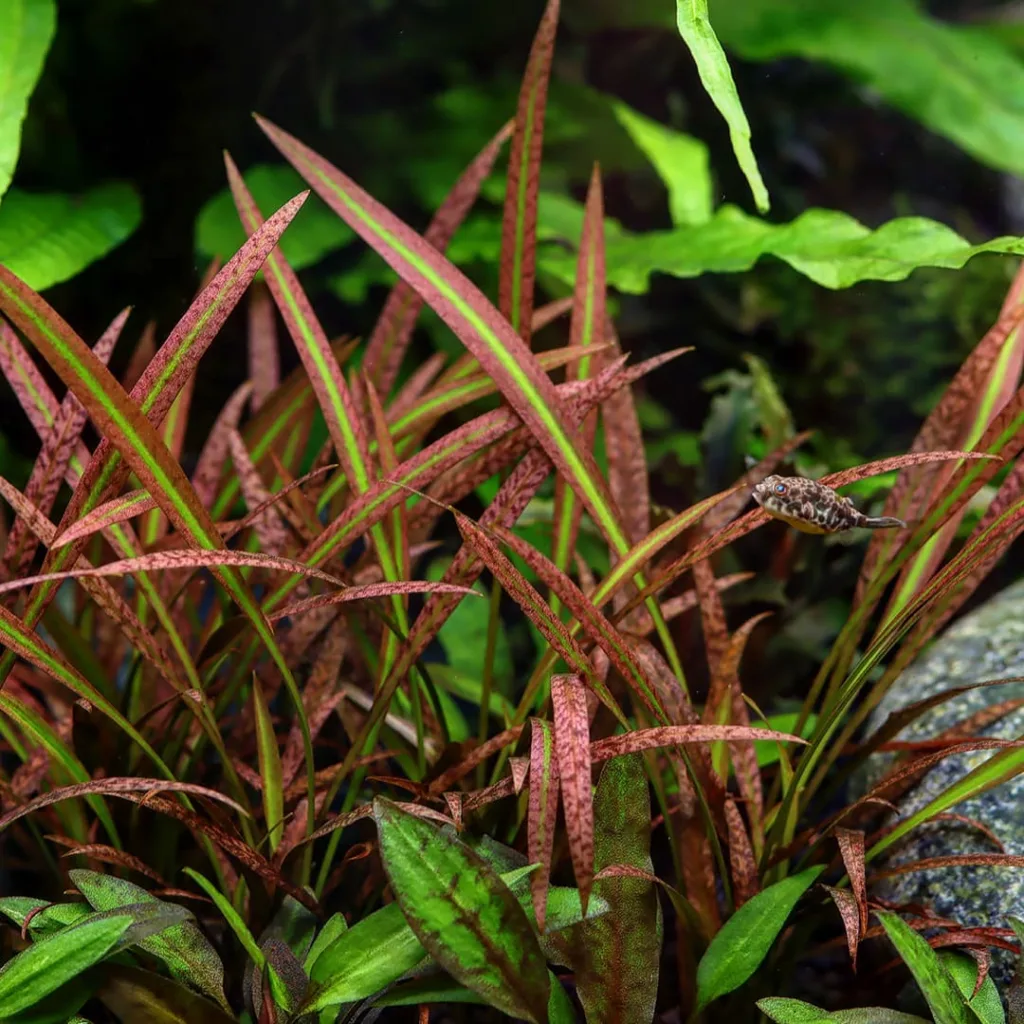
Source: @anubiasaquaticplants
First on my list is Anubias, a hardy plant that’s perfect for beginners. Anubias blooms with a white blossom that is simple yet attractive and can elevate any aquarium. It’s a low-maintenance plant, preferring shaded areas and requiring minimal light. One thing I’ve learned is to never bury its rhizome completely in the substrate; mounting it on rocks or driftwood can enhance its growth and flowering potential.
Echinodorus (Amazon Sword)
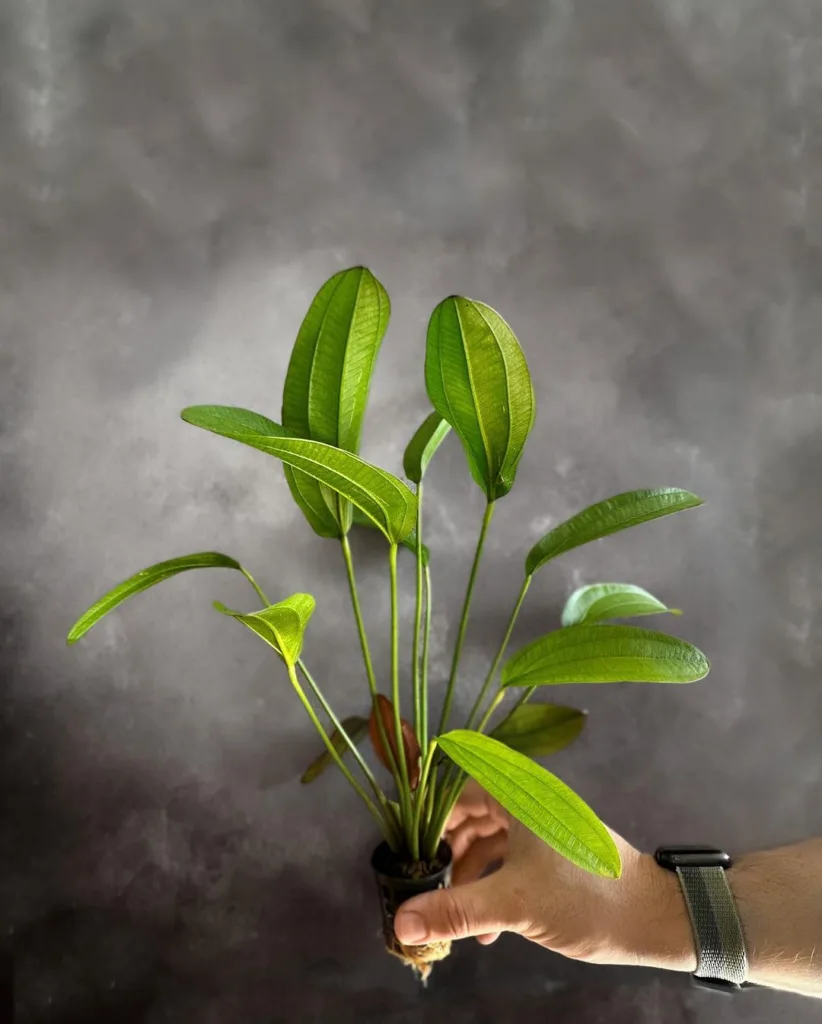
Source: @botanygeek
Echinodorus, widely known as the Amazon Sword, is another favorite of mine. It’s not just its size and greenery that make it appealing but also its capability to produce a stalk with small, delicate white flowers. This plant loves rich substrate and plenty of light. In my tanks, I ensure a regular supply of iron-based supplements to encourage lush growth and blooming.
Cryptocoryne
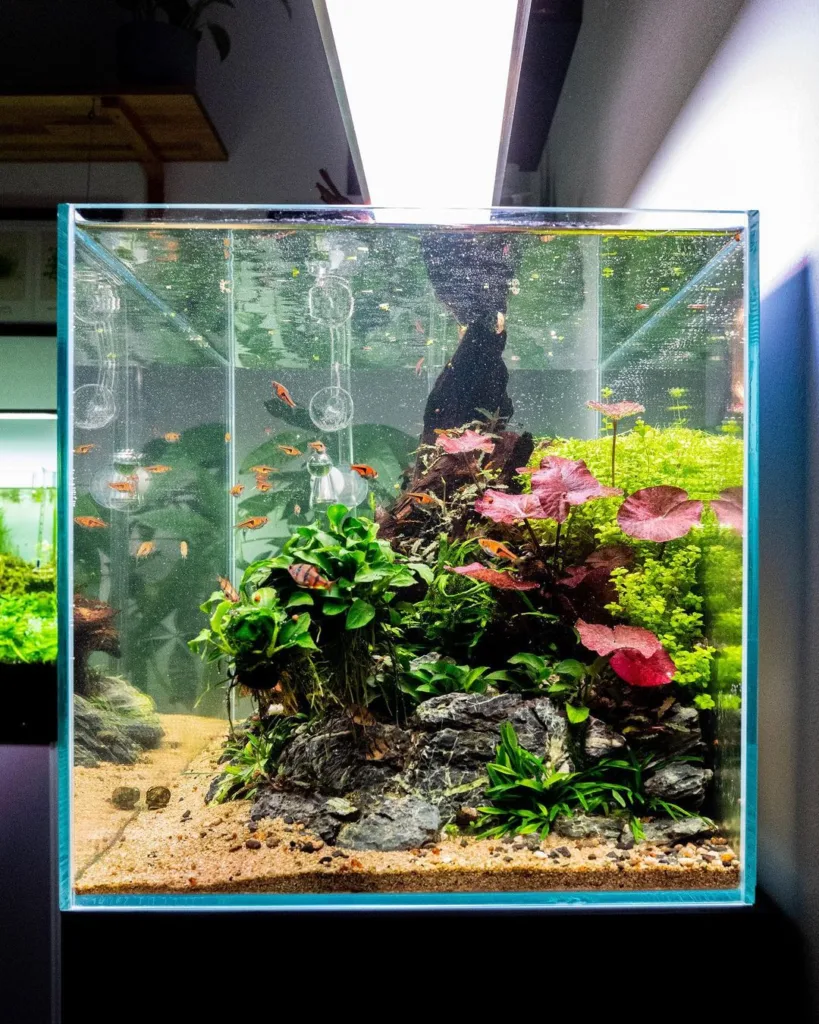
Source: @pachi_aquarium
Cryptocoryne is a bit of a wild card. Its flowers, known as spathes, are unique and come in various colors depending on the species. From my experience, Cryptocorynes require stable conditions to thrive and flower. Abrupt changes in water parameters can lead to “crypt melt”. However, with patience and care, witnessing its flowering underwater is truly rewarding.
Aponogeton
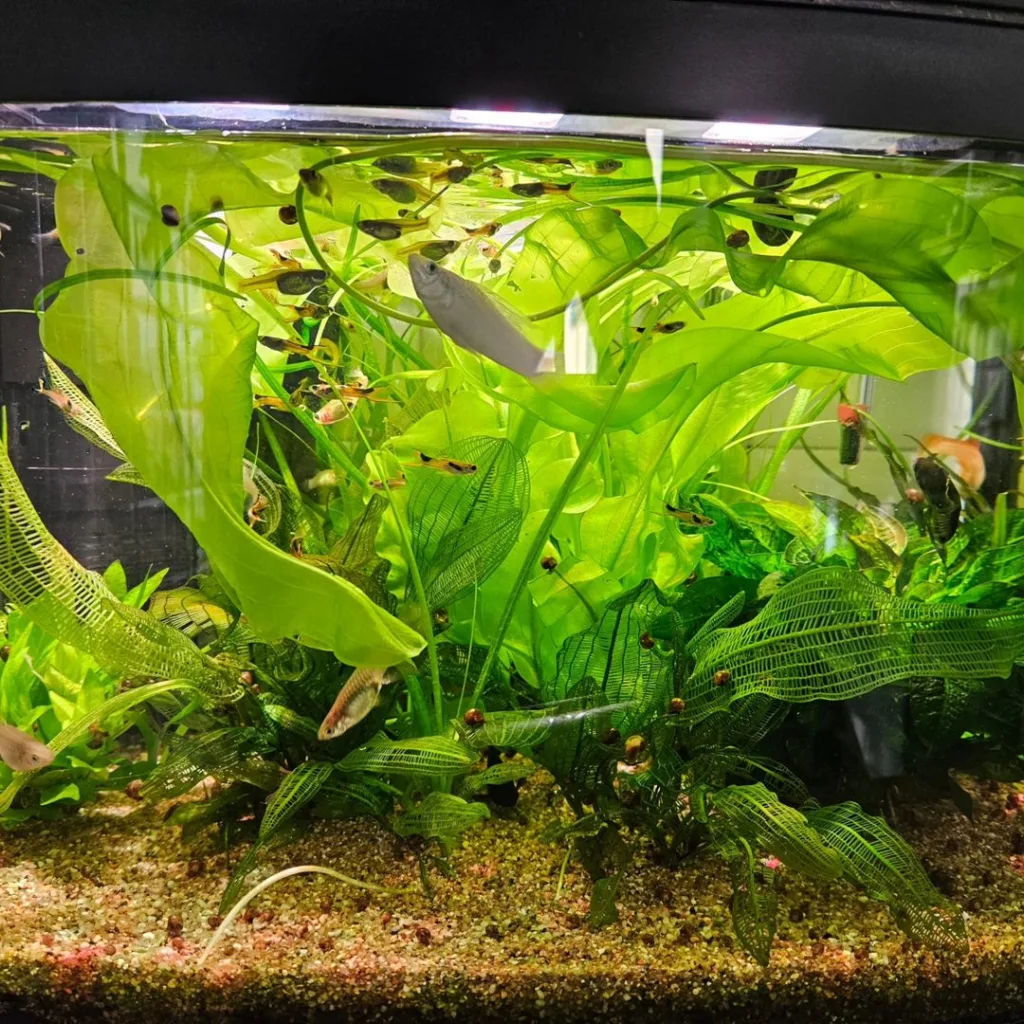
Source: @yordan_avd
Last but not least, Aponogeton produces some of the most dramatic blooms, which can be a striking addition above the water’s surface. These plants are known for their bulbous nature and rapid growth under the right conditions. They love cooler temperatures and a period of dormancy to bloom. Feeding them with a balanced diet and providing ample light are my go-to strategies for encouraging flowers.
Low-Maintenance Flowering Aquarium Plants
For those just stepping into the world of aquascaping, starting with low-maintenance flowering plants can be a game changer. Based on my own aquarium adventures, I’ve found that certain species are just ideal for beginners.
These plants are hardy, grow at a steady pace, and are forgiving—even if your green thumb is yet to develop. They blend seamlessly into various tank setups, enriching your aquatic environment without demanding much in return. Here, I’ll guide you through some easy-to-care-for flowering plants that bring life and color to your tank with minimal effort.
Java Fern

Source: @scapeling
One of the most resilient aquarium plants I’ve come across is the Java Fern. This plant does not bloom frequently, but when it does, its subtle flowers add an understated charm to your aquarium. Its strong suit lies in its ease of care. Java Ferns prefer low to moderate light and can be simply tied to a piece of driftwood or a rock. They’re virtually impossible to kill, making them perfect for beginners.
Hornwort

Source: @hoffmans_waterxscapes
Though not traditionally known for its flowers, Hornwort can produce small and inconspicuous flowers above water if the conditions are just right. The true allure of this plant is how quickly it grows and how well it can adjust to different types of water.
It’s a floating plant or can be anchored in substrate, making it versatile for different tank setups. Hornwort is a great option for those looking to improve water quality, as it’s excellent at absorbing excess nutrients.
Moss Balls
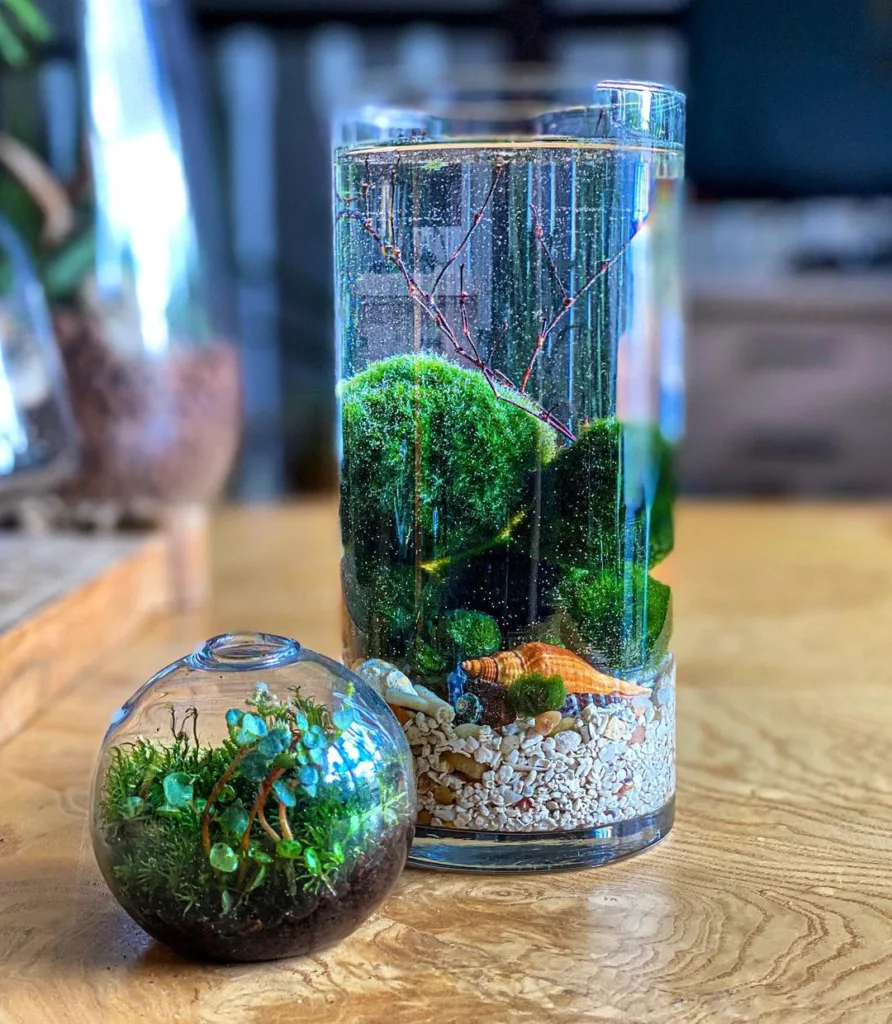
Source: @doodlebirdterrariums
While Moss Balls don’t flower in the traditional sense, their unique appearance and extremely low maintenance make them a noteworthy mention. These aren’t just intriguing to look at; they also serve as natural filters, aiding in the removal of nitrates from your tank water. Just give them a gentle rinse and a squeeze in clean aquarium water every now and then, and rotate them for even light exposure.
Advanced Care Flowering Aquarium Plants
Diving deeper into the aquascaping realm reveals a category of flowering aquarium plants that are as rewarding as they are challenging. These beauties require a gardener’s finesse, a touch more science, and a committed heart. For those ready to elevate their aquatic gardens, understanding the needs of advanced care flowering aquarium plants is crucial.
From my own aquascaping journeys, I’ve accumulated a trove of insights on how to nurture these demanding species. It’s a blend of the right conditions, timely care, and responding to their unique demands that transforms a simple tank into an underwater Eden.
CO2 Supplementation
A pivotal element in the advanced aquarist’s toolkit is CO2 supplementation. Plants like Ludwigia Repens and Rotala Wallichii not only demand a precise CO2 level but flourish when it’s delicately balanced. I’ve observed firsthand how CO2 injection, when dialed in to the sweet spot, can spur growth and intensify the flowering potential of these species.
Maintaining a consistent CO2 level requires vigilance and a good quality regulator. The transformation in plant vitality and blooming frequency is nothing short of astonishing.
Specialized Lighting
Lighting is not just about intensity; it’s about spectrum, duration, and even placement. High-light-demand plants such as Blyxa Japonica thrive under conditions that mimic the tropical sun. I’ve experimented with various lighting systems and found that LED lights with programmable settings offer unparalleled control over light intensity and spectrum. This enables me to create a cycle that mimics natural daylight hours, encouraging robust growth and flowering.
Nutrient Dosing
The art and science of nutrient dosing can be likened to gourmet cooking for plants. Each species has its preferred menu; for instance, Eriocaulon species are known for their demanding nutrient requirements. It’s a fine balance of macro and micro-nutrients, typically administered through liquid fertilizers.
My approach involves regular testing of water parameters and adjusting doses to meet the specific needs of my plants, ensuring they receive the perfect blend of nutrients to support their growth and flowering.
Managing Algae Growth
A common challenge in high-nutrient, high-light aquariums is the unwelcome guest of algae. Effective algae management, in my experience, involves a combination of manual removal, chemical treatments, and introducing algae-eating fish or invertebrates. It’s critical to address the cause, be it excessive light, nutrient imbalances, or poor circulation, to keep the focus on your plants’ health and beauty.
The Joy of Experimentation
Venturing into the care of advanced flowering aquarium plants is a journey of discovery and learning. There’s joy in the experimentation, and each tank becomes a personal laboratory. The successes are visually stunning and deeply satisfying, while the setbacks are opportunities to learn and adjust.
It’s this dynamic interplay of care, observation, and adaptation that makes aquatic gardening endlessly fascinating.
Designing with Flowering Aquarium Plants
Incorporating flowering plants into your aquarium can dramatically elevate the visual intricacy and dynamic of your aquascape. Based on my experience, strategic placement and a thoughtful selection of species can transform your tank into a living piece of art. Here, I’ll share some insights on how to weave these floral gems into your aquatic tapestry effectively.
Background Planting Strategies
For the background area of your tank, tall plants like Ludwigia Repens or Rotala Wallichii are superb choices. They not only add depth and height but also serve as a perfect backdrop for the blossoms to stand out against. Ensure these plants are placed where they won’t cast shadows on smaller species, allowing for an even distribution of light throughout the tank.
Midground Considerations
The midground is your canvas for creativity. Here, flowering plants of medium height, such as certain Cryptocoryne species, can add bursts of color and texture. Placing flowering plants in this zone helps bridge the visual gap between the towering background species and the low-lying foreground, creating a cohesive look.
Foreground and Accent Plants
In the foreground, consider using shorter, flowering plants that can flourish under the shade of taller species. Small blooms can add an unexpected pop of color at eye level, captivating viewers with their delicate beauty. Plants like Anubias nana petite with its subtle flowers can serve as excellent focal points without overpowering the composition.
Enhancing Visual Appeal and Biodiversity
Flowering plants do more than just beautify the aquarium—they introduce complexity and biodiversity to your aquatic ecosystem. The different textures, colors, and shapes of flowering plants create a rich tapestry that mimics natural water bodies, providing a more stimulating environment for your fish and invertebrates.
Furthermore, a balanced ecology may be established with the assistance of the varied flora, which will improve the general stability and health of your aquarium.
Experimentation and Personal Touch
Don’t be afraid to experiment with the placement and combination of flowering plants. Each tank is unique, and finding the right balance often requires trial and adjustment. Remember, aquascaping is a personal art form—what matters most is creating a space that you find beautiful and fulfilling.
Propagation and Reproduction of Flowering Aquarium Plants
Venturing into the propagation of flowering aquarium plants can be immensely rewarding. Through my experiences, I’ve found a few methods particularly effective for multiplying these aquatic beauties. Here, I’ll guide you through the nuances of stem cutting, division, and seed propagation, ensuring even beginners can succeed in expanding their submerged gardens.
Stem Cutting
Stem cutting is perhaps the simplest method to propagate many species of aquatic plants, including favorites like Ludwigia and Rotala. Here’s how you can do it:
- Identify a healthy stem that’s free of disease and pests.
- With a sharp, clean pair of scissors, cut a section of the stem, ensuring it has several leaves or nodes.
- Plant the cutting into the substrate, making sure a couple of nodes are buried to encourage root growth.
- Maintain proper lighting and nutrient levels to support the cutting’s development into a new, independent plant.
Division
Division is ideal for spreading plants that grow in clumps or rosettes, such as Cryptocoryne. The process involves:
- Gently removing the plant from the substrate, being careful to minimize root damage.
- Divide the plant at the root ball into smaller portions, each with its own roots and leaves, using your fingers or a clean knife.
- Replant the divisions at the desired locations in your aquarium.
Seed Propagation
While more challenging, growing plants from seeds allows aquarists to experience the full lifecycle of their aquatic plants. The process varies by species, but generally involves:
- Allowing flowers to naturally pollinate and produce seeds, which can be collected once mature.
- Scattering the seeds on the substrate or in a breeding tray filled with water.
- Providing ample lighting and possibly a gentle water flow to mimic natural conditions until germination occurs.
Troubleshooting and Common Issues
Despite best efforts, flowering aquarium plants sometimes face challenges. Algae overgrowth, nutrient deficiencies, and pests can mar the beauty of your aquascape and threaten plant health.
Combating Algae
Algae thrive on excess nutrients and light. To combat algae:
- Reduce lighting duration and intensity.
- Perform regular water changes to control nutrient levels.
- Introduce algae-eating companions like certain species of fish and snails.
Addressing Nutrient Deficiencies
Yellowing leaves or stunted growth often signal nutrient deficiencies. To remedy this:
- Test your water regularly for nutrient levels.
- Adjust your fertilization routine accordingly, ensuring a balanced supply of macro and micro-nutrients.
Managing Pests
Pests like snails or aphids can be detrimental. To manage pests:
- Physically remove visible pests.
- Introduce natural predators into your aquarium.
- In severe cases, consider safe chemical treatments, always following instructions to avoid harming your plants and fish.
My Opinion
In my experience, the world of flowering aquarium plants is a vast and vibrant one, offering endless possibilities to aquarists passionate about bringing a splash of color and life to their underwater landscapes. From the towering elegance of Ludwigia Repens to the understated beauty of Anubias nana petite, each plant brings its own unique character to the aquarium.
Experimenting with different species and placement has been a deeply rewarding aspect of my aquascaping adventure, allowing me to craft aquatic ecosystems that are not just visually engaging but also beneficial for the inhabitants. Whether you’re just starting out or looking to add a new dimension to your established tank, I invite you to investigate the wide variety of blooming aquarium plants. Their ability to transform an aquarium from a simple fish tank into a living work of art is truly unparalleled.
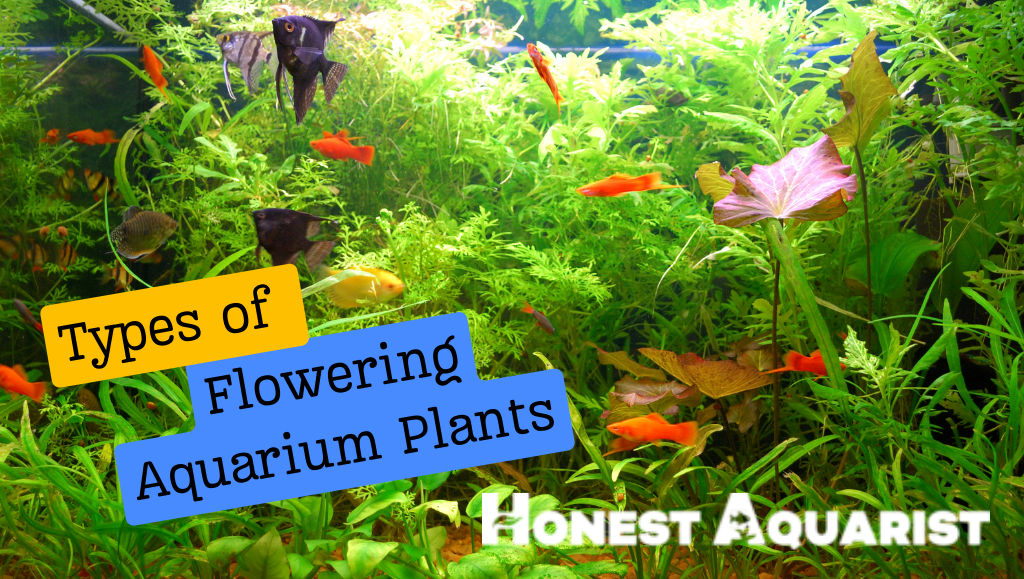

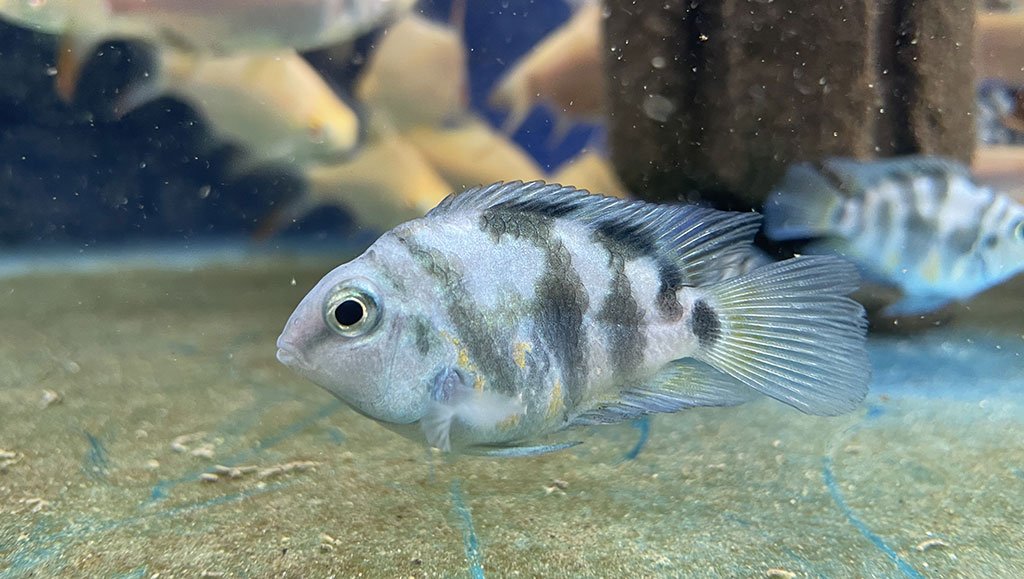


Thanks, I have just been looking for information about this subject for a long time and yours is the best I’ve discovered till now. However, what in regards to the bottom line? Are you certain in regards to the supply?
We’re delighted to hear that you’ve found our information helpful! Regarding your question about the bottom line and our supply, we want to assure you that we strive to provide accurate and reliable information to our visitors. Our team is dedicated to sourcing our products from reputable suppliers and ensuring the highest standards of quality. If you have any specific concerns or questions about our supply chain, please feel free to let us know, and we’ll be happy to address them. Thank you for your interest and trust in Honest Aquarist!
Lirigzon Gashi